Rectangle diagrams for the Lusztig cones of quantized enveloping algebras of type A
- 格式:pdf
- 大小:268.81 KB
- 文档页数:21
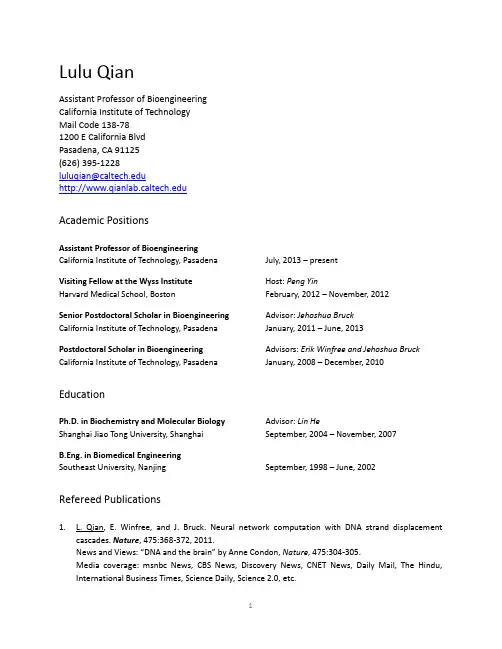
Lulu QianAssistant Professor of BioengineeringCalifornia Institute of TechnologyMail Code 138-781200 E California BlvdPasadena, CA 91125(626) 395-1228********************Academic PositionsAssistant Professor of BioengineeringCalifornia Institute of Technology, Pasadena July, 2013 – presentVisiting Fellow at the Wyss Institute Host: Peng YinHarvard Medical School, Boston February, 2012 – November, 2012Senior Postdoctoral Scholar in Bioengineering Advisor: Jehoshua BruckCalifornia Institute of Technology, Pasadena January, 2011 – June, 2013Postdoctoral Scholar in Bioengineering Advisors: Erik Winfree and Jehoshua Bruck California Institute of Technology, Pasadena January, 2008 – December, 2010EducationPh.D. in Biochemistry and Molecular Biology Advisor: Lin HeShanghai Jiao Tong University, Shanghai September, 2004 – November, 2007B.Eng. in Biomedical EngineeringSoutheast University, Nanjing September, 1998 – June, 2002Refereed Publications1.L. Qian, E. Winfree, and J. Bruck. Neural network computation with DNA strand displacementcascades. Nature, 475:368-372, 2011.News and Views: “DNA and the brain” by Ann e Condon, Nature, 475:304-305.Media coverage: msnbc News, CBS News, Discovery News, CNET News, Daily Mail, The Hindu, International Business Times, Science Daily, Science 2.0, etc.2.L. Qian and E. Winfree. Scaling up digital circuit computation with DNA strand displacementcascades. Science, 332:1196-1201, 2011.Perspective: “Scaling up DNA computation” by John Reif, Science, 332:1156-1167.News and Views: “DNA computes a square root” by Yaakov Benenson, Nature Nanotechnology, 6:465-467.Media coverage: BBC News, Los Angeles Times, Nature News, Discovery News, Popular Science, Popular Mechanics, New Scientist, Science News, PC World, etc.3.L. Qian and E. Winfree. A simple DNA gate motif for synthesizing large-scale circuits. Journal of theRoyal Society Interface, 8:1281-1297, 2011. Conference version appeared in A. Goel, F. C. Simmel and P. Sosik, editors, DNA Computing and Molecular Programming, LNCS, volume 5347, pages 70-89, Springer, 2009.4.L. Qian, D. Soloveichik, and E. Winfree. Efficient Turing-universal computation with DNA polymers.In Y. Sakakibara and Y. Mi, editors, DNA Computing and Molecular Programming, LNCS, volume 6518, pages 123-140, Springer, 2011.5.Z. Zhang, Y. Wang, C. Fan, C. Li, Y. Li, L. Qian, Y. Fu, Y. Shi, J. Hu, and L. He. Asymmetric DNA origamifor spatially addressable and index-free solution-phase DNA chips. Advanced Materials, 22:2672-2675, 2010.6.L. Qian*, J. Zhao*, Y. Shi, X. Zhao, G. Feng, F. Xu, S. Zhu, and L. He. Brain-derived neurotrophic factorand risk of schizophrenia: an association study and meta-analysis. Biochemical and biophysical research communications, 353:738-743, 2007.7.J. Zhao*, L. Qian*, Q. Liu, Z. Zhang, and L. He. DNA addition using linear self-assembly. ChineseScience Bulletin, 52:1462-1467, 2007.8.L. Qian, Y. Wang, Z. Zhang, J. Zhao, D. Pan, Y. Zhang, Q. Liu, C. Fan, J. Hu, and L. He. Analogic Chinamap constructed by DNA. Chinese Science Bulletin, 51:2973-2976, 2006.9.J. Xie, Y. Bai, L. Qian, L. Cui, X. Sun, and Z. Lu. A computer simulation system of DNA-binding proteinexperiment based on dsDNA microarray. Acta Biophysica Sinica, 19:156-160, 2003.Google Scholar citationAcademic Talks1.Biology & Biological Engineering Annual Retreat (Lake Arrowhead, CA, September 2013)2.19th Conference on DNA Computing and Molecular Programming (Tempe, AZ, September 2013).3.University of California, Riverside, Bioengineering (Riverside, CA, April 2013)4.Frontiers of Information Science and Technology Workshop (Shanghai, China, December 2012)5.Massachusetts Institute of Technology, Mechanical Engineering (Cambridge, MA, March 2012)6.University of California, San Francisco, Cellular and Molecular Pharmacology (San Francisco, CA,February 2012)7.University of Texas at Austin, Chemistry and Biochemistry (Austin, TX, February 2012)8.University of Oxford, Physics (Oxford, UK, July 2011).9.3rd Molecular Programming Project Workshop (Friday Harbor, WA, June 2011).10.International Conference on the Statistical Mechanics and Computation of DNA Self-Assembly(Mariehamn, Finland, May 2011).11.8th Conference on the Foundations of Nanoscience (Snowbird, UT, April 2011).12.9th International Conference on Unconventional Computation (Tokyo, Japan, June 2010).13.16th Conference on DNA Computing and Molecular Programming (Hong Kong, June 2010).14.7th Conference on the Foundations of Nanoscience (Snowbird, UT, April 2010).15.Institute of Biological Engineering Annual Conference (Cambridge, MA, March 2010).16.University of Minnesota, Electrical & Computer Engineering (Minneapolis, MN, January 2010).17.2nd Molecular Programming Project Workshop (Oxnard, CA, January 2010).18.University of British Columbia, Computer Science (Vancouver, Canada, December 2009).19.Boise State University, Materials Science & Engineering (Boise, ID, September 2009).20.15th Conference on DNA Computing and Molecular Programming (Fayetteville, AR, June 2009).21.6th Conference on the Foundations of Nanoscience (Snowbird, UT, April 2009).22.National Center for Nanoscience and Technology (Beijing, China, April 2009).23.1st Molecular Programming Project Workshop (Oxnard, CA, January 2009).24.University of Science and Technology of China, Chemistry (Hefei, China, October 2008).25.Shanghai Jiao Tong University, Bio-X Center (Shanghai, China, October 2008).26.17th International Workshop on Logic & Synthesis (Lake Tahoe, CA, January 2008).Awards and Recognition1.National Science Foundation Faculty Early Career Development Award, 20132.Okawa Foundation Research Award, 20133.Burroughs Wellcome Fund Career Award at the Scientific Interface, 2012Academic Service1.Refereeing for Nature, Nature Biotechnology, Angewandte Chemie, Chemical Science, NeuralComputation, Scientific Reports, Acta Biophysica Sinica.。
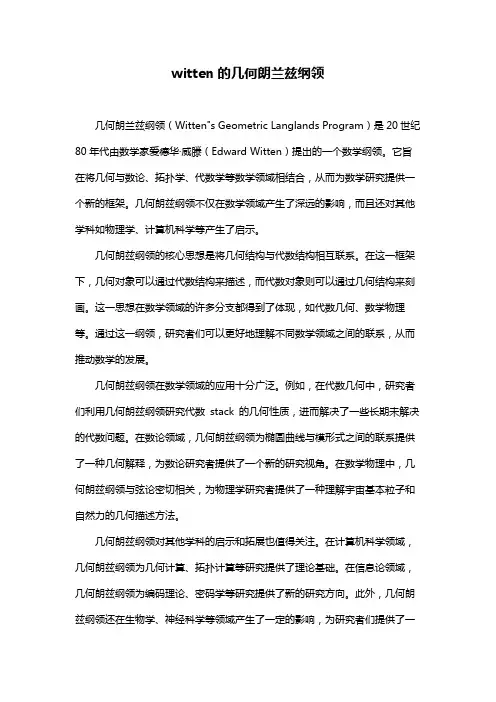
witten的几何朗兰兹纲领几何朗兰兹纲领(Witten"s Geometric Langlands Program)是20世纪80年代由数学家爱德华·威滕(Edward Witten)提出的一个数学纲领。
它旨在将几何与数论、拓扑学、代数学等数学领域相结合,从而为数学研究提供一个新的框架。
几何朗兹纲领不仅在数学领域产生了深远的影响,而且还对其他学科如物理学、计算机科学等产生了启示。
几何朗兹纲领的核心思想是将几何结构与代数结构相互联系。
在这一框架下,几何对象可以通过代数结构来描述,而代数对象则可以通过几何结构来刻画。
这一思想在数学领域的许多分支都得到了体现,如代数几何、数学物理等。
通过这一纲领,研究者们可以更好地理解不同数学领域之间的联系,从而推动数学的发展。
几何朗兹纲领在数学领域的应用十分广泛。
例如,在代数几何中,研究者们利用几何朗兹纲领研究代数stack 的几何性质,进而解决了一些长期未解决的代数问题。
在数论领域,几何朗兹纲领为椭圆曲线与模形式之间的联系提供了一种几何解释,为数论研究者提供了一个新的研究视角。
在数学物理中,几何朗兹纲领与弦论密切相关,为物理学研究者提供了一种理解宇宙基本粒子和自然力的几何描述方法。
几何朗兹纲领对其他学科的启示和拓展也值得关注。
在计算机科学领域,几何朗兹纲领为几何计算、拓扑计算等研究提供了理论基础。
在信息论领域,几何朗兹纲领为编码理论、密码学等研究提供了新的研究方向。
此外,几何朗兹纲领还在生物学、神经科学等领域产生了一定的影响,为研究者们提供了一种全新的几何视角来研究生物结构和神经网络。
总之,几何朗兹纲领作为一个跨学科的数学纲领,具有极高的学术价值和实用价值。
它为数学领域的研究提供了一种新的理论框架,推动了数学的发展。
同时,几何朗兹纲领还对其他学科产生了深远的影响,促进了多学科交叉研究的开展。
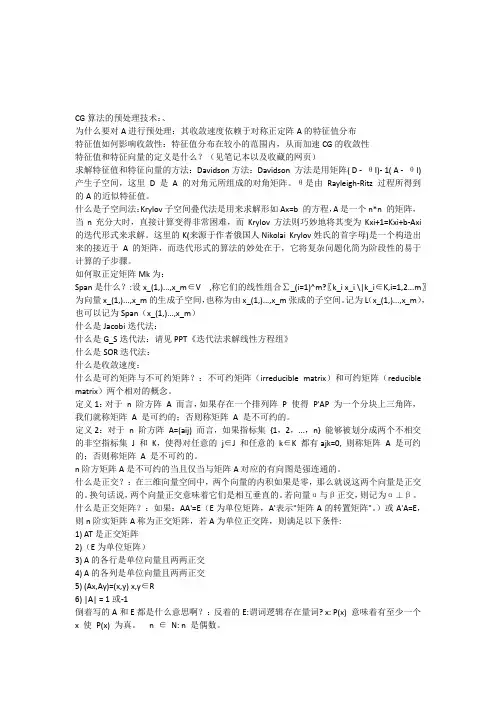
CG算法的预处理技术:、为什么要对A进行预处理:其收敛速度依赖于对称正定阵A的特征值分布特征值如何影响收敛性:特征值分布在较小的范围内,从而加速CG的收敛性特征值和特征向量的定义是什么?(见笔记本以及收藏的网页)求解特征值和特征向量的方法:Davidson方法:Davidson 方法是用矩阵( D - θI)- 1( A - θI) 产生子空间,这里D 是A 的对角元所组成的对角矩阵。
θ是由Rayleigh-Ritz 过程所得到的A的近似特征值。
什么是子空间法:Krylov子空间叠代法是用来求解形如Ax=b 的方程,A是一个n*n 的矩阵,当n充分大时,直接计算变得非常困难,而Krylov方法则巧妙地将其变为Kxi+1=Kxi+b-Axi 的迭代形式来求解。
这里的K(来源于作者俄国人Nikolai Krylov姓氏的首字母)是一个构造出来的接近于A的矩阵,而迭代形式的算法的妙处在于,它将复杂问题化简为阶段性的易于计算的子步骤。
如何取正定矩阵Mk为:Span是什么?:设x_(1,)...,x_m∈V ,称它们的线性组合∑_(i=1)^m?〖k_i x_i \|k_i∈K,i=1,2...m〗为向量x_(1,)...,x_m的生成子空间,也称为由x_(1,)...,x_m张成的子空间。
记为L(x_(1,)...,x_m),也可以记为Span(x_(1,)...,x_m)什么是Jacobi迭代法:什么是G_S迭代法:请见PPT《迭代法求解线性方程组》什么是SOR迭代法:什么是收敛速度:什么是可约矩阵与不可约矩阵?:不可约矩阵(irreducible matrix)和可约矩阵(reducible matrix)两个相对的概念。
定义1:对于n 阶方阵A 而言,如果存在一个排列阵P 使得P'AP 为一个分块上三角阵,我们就称矩阵A 是可约的;否则称矩阵A 是不可约的。
定义2:对于n 阶方阵A=(aij) 而言,如果指标集{1,2,...,n} 能够被划分成两个不相交的非空指标集J 和K,使得对任意的j∈J 和任意的k∈K 都有ajk=0, 则称矩阵 A 是可约的;否则称矩阵A 是不可约的。
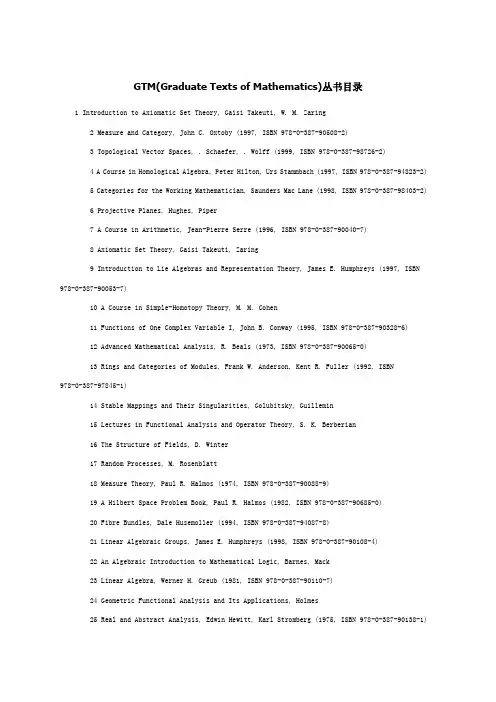
GTM(Graduate Texts of Mathematics)丛书目录1 Introduction to Axiomatic Set Theory, Gaisi Takeuti, W. M. Zaring2 Measure and Category, John C. Oxtoby (1997, ISBN 978-0-387-90508-2)3 Topological Vector Spaces, . Schaefer, . Wolff (1999, ISBN 978-0-387-98726-2)4 A Course in Homological Algebra, Peter Hilton, Urs Stammbach (1997, ISBN 978-0-387-94823-2)5 Categories for the Working Mathematician, Saunders Mac Lane (1998, ISBN 978-0-387-98403-2)6 Projective Planes, Hughes, Piper7 A Course in Arithmetic, Jean-Pierre Serre (1996, ISBN 978-0-387-90040-7)8 Axiomatic Set Theory, Gaisi Takeuti, Zaring9 Introduction to Lie Algebras and Representation Theory, James E. Humphreys (1997, ISBN 978-0-387-90053-7)10 A Course in Simple-Homotopy Theory, M. M. Cohen11 Functions of One Complex Variable I, John B. Conway (1995, ISBN 978-0-387-90328-6)12 Advanced Mathematical Analysis, R. Beals (1973, ISBN 978-0-387-90065-0)13 Rings and Categories of Modules, Frank W. Anderson, Kent R. Fuller (1992, ISBN978-0-387-97845-1)14 Stable Mappings and Their Singularities, Golubitsky, Guillemin15 Lectures in Functional Analysis and Operator Theory, S. K. Berberian16 The Structure of Fields, D. Winter17 Random Processes, M. Rosenblatt18 Measure Theory, Paul R. Halmos (1974, ISBN 978-0-387-90088-9)19 A Hilbert Space Problem Book, Paul R. Halmos (1982, ISBN 978-0-387-90685-0)20 Fibre Bundles, Dale Husemoller (1994, ISBN 978-0-387-94087-8)21 Linear Algebraic Groups, James E. Humphreys (1998, ISBN 978-0-387-90108-4)22 An Algebraic Introduction to Mathematical Logic, Barnes, Mack23 Linear Algebra, Werner H. Greub (1981, ISBN 978-0-387-90110-7)24 Geometric Functional Analysis and Its Applications, Holmes25 Real and Abstract Analysis, Edwin Hewitt, Karl Stromberg (1975, ISBN 978-0-387-90138-1)26 Algebraic Theories, Manes27 General Topology, John L. Kelley (1975, ISBN 978-0-387-90125-1)28 Commutative Algebra I, Oscar Zariski, Pierre Samuel, Cohen (1975, ISBN 978-0-387-90089-6)29 Commutative Algebra II, Oscar Zariski, Pierre Samuel30 Lectures in Abstract Algebra I, Nathan Jacobson31 Lectures in Abstract Algebra II, Nathan Jacobson32 Lectures in Abstract Algebra III, Nathan Jacobson33 Differential Topology, Morris W. Hirsch34 Principles of Random Walk, Frank Spitzer35 Several Complex Variables and Banach Algebras, Herbert Alexander, John Wermer36 Linear Topological Spaces, John L. Kelley, Isaac Namioka37 Mathematical Logic, J. Donald Monk38 Several Complex Variables, Grauert, Fritzsche39 An Invitation to C * -Algebras, William Arveson40 Denumerable Markov Chains, John George Kemeny, Snell, Knapp et al.41 Modular Functions and Dirichlet Series in Number Theory, Tom M. Apostol42 Linear Representations of Finite Groups, Jean-Pierre Serre, Scott43 Rings of Continuous Functions, Gillman, Jerison44 Elementary Algebraic Geometry, K. Kendig45 Probability Theory I, M. Loève46 Probability Theory II, M. Loève47 Geometric Topology in Dimensions 2 and 3, Edwin E. Moise48 General Relativity for Mathematicians, . Sachs, H. Wu49 Linear Geometry, . Gruenberg, . Weir50 Fermat's Last Theorem, Harold M. Edwards51 A Course in Differential Geometry, Klingenberg52 Algebraic Geometry, Robin Hartshorne53 A Course in Mathematical Logic, Yu. I. Manin54 Combinatorics with Emphasis on the Theory of Graphs, Graver, Watkins55 Introduction to Operator Theory I, Brown, Pearcy56 Algebraic Topology: An Introduction, William S. Massey57 Introduction to Knot Theory, Richard H. Crowell, Ralph H. Fox (1977, ISBN 978-0-387-90272-2)58 P-adic Numbers, p-adic Analysis, and Zeta-Functions, Neal Koblitz59 Cyclotomic Fields, Serge Lang60 Mathematical Methods of Classical Mechanics, V. I. Arnold61 Elements of Homotopy Theory, George W. Whitehead62 Fundamentals of the Theory of Groups, Kargapolov, Merzljakov, Burns63 Graph Theory, Béla Bollobás64 Fourier Series I, Edwards65 Differential Analysis on Complex Manifolds, . Wells Jr.66 Introduction to Affine Group Schemes, . Waterhouse67 Local Fields, Jean-Pierre Serre, Greenberg68 Linear Operators on Hilbert Spaces, Weidmann, Szuecs69 Cyclotomic Fields II, Serge Lang70 Singular Homology Theory, William S. Massey71 Riemann Surfaces, Herschel Farkas, Irwin Kra72 Classical Topology and Combinatorial Group Theory, John Stillwell73 Algebra, Thomas W. Hungerford74 Multiplicative Number Theory, Harold Davenport, Hugh Montgomery75 Basic Theory of Algebraic Groups and Lie Algebras, G. P. Hochschild76 Algebraic Geometry, Iitaka77 Lectures on the Theory of Algebraic Numbers, Hecke, Brauer, Goldman et al.78 A Course in Universal Algebra, Burris, Sankappanavar (Online [1])79 An Introduction to Ergodic Theory, Peter Walters80 A Course in the Theory of Groups, Derek . Robinson81 Lectures on Riemann Surfaces, Forster, Gilligan82 Differential Forms in Algebraic Topology, Raoul Bott, Loring Tu83 Introduction to Cyclotomic Fields, Lawrence C. Washington84 A Classical Introduction to Modern Number Theory, Ireland, Rosen (1995, ISBN 0-387-97329-X)85 Fourier Series A Modern Introduction, R. E. Edwards86 Introduction to Coding Theory, . van Lint (3rd ed 1998, ISBN 3-540-64133-5)87 Cohomology of Groups, Kenneth S. Brown88 Associative Algebras, . Pierce89 Introduction to Algebraic and Abelian Functions, Serge Lang90 An Introduction to Convex Polytopes, Arne Brondsted91 The Geometry of Discrete Groups, Alan F. Beardon92 Sequences and Series in Banach Spaces, J. Diestel93 Modern Geometry - Methods and Applications I, Dubrovin, Fomenko, Novikov et al.94 Foundations of Differentiable Manifolds and Lie Groups, Frank W. Warner95 Probability, Shiryaev, Boas96 A Course in Functional Analysis, John B. Conway97 Introduction to Elliptic Curves and Modular Forms, Neal Koblitz98 Representations of Compact Lie Groups, Broecker, Dieck99 Finite Reflection Groups, Grove, Benson100 Harmonic Analysis on Semigroups, Berg, Christensen, Ressel101 Galois Theory, Harold M. Edwards102 Lie Groups, Lie Algebras, and Their Representations, V. S. Varadarajan103 Complex Analysis, Serge Lang104 Modern Geometry - Methods and Applications II, Dubrovin, Fomenko, Novikov et al.105 SL2®, Serge Lang106 The Arithmetic of Elliptic Curves, Joseph H. Silverman107 Applications of Lie Groups to Differential Equations, Peter J. Olver108 Holomorphic Functions and Integral Representations in Several Complex Variables, R. Michael Range109 Univalent Functions and Teichmüller Spaces, O. Lehto110 Algebraic Number Theory, Serge Lang111 Elliptic Curves, Dale Husemöller112 Elliptic Functions, Serge Lang113 Brownian Motion and Stochastic Calculus, Ioannis Karatzas, Steven Shreve114 A Course in Number Theory and Cryptography, Neal Koblitz115 Differential Geometry, Berger, Gostiaux, Levy116 Measure and Integral, John L. Kelley, Srinivasan117 Algebraic Groups and Class Fields, Jean-Pierre Serre118 Analysis Now, Gert K. Pedersen119 An Introduction to Algebraic Topology, Joseph J. Rotman120 Weakly Differentiable Functions, William P. Ziemer121 Cyclotomic Fields I-II, Serge Lang, Karl Rubin122 Theory of Complex Functions, Remmert, Burckel123 Numbers, Lamotke, Ewing, Ebbinghaus et al.124 Modern Geometry - Methods and Applications III, B. A. Dubrovin, Anatoly Timofeevich Fomenko, Sergei Petrovich Novikov et al. (1990, ISBN 978-0-387-97271-8)125 Complex Variables, Berenstein, Gay126 Linear Algebraic Groups, Armand Borel127 A Basic Course in Algebraic Topology, William S. Massey128 Partial Differential Equations, Jeffrey Rauch129 Representation Theory, William Fulton, Joe Harris130 Tensor Geometry, Dodson, T. Poston131 A First Course in Noncommutative Rings, . Lam132 Iteration of Rational Functions, Alan F. Beardon133 Algebraic Geometry, Joe Harris134 Coding and Information Theory, Steven Roman135 Advanced Linear Algebra, Steven Roman136 Algebra, Adkins, Weintraub137 Harmonic Function Theory, Axler, Bourdon, Ramey138 A Course in Computational Algebraic Number Theory, Henri Cohen (1996, ISBN 0-387-55640-0) 139 Topology and Geometry, Glen E. Bredon140 Optima and Equilibria, Jean-Pierre Aubin141 Gröbn er Bases, Becker, Weispfenning, Kredel142 Real and Functional Analysis, Serge Lang, (1993, ISBN 14)143 Measure Theory, . Doob144 Noncommutative Algebra, Farb, Dennis145 Homology Theory, James W. Vick146 Computability, Douglas S. Bridges147 Algebraic K-Theory and Its Applications, Jonathan Rosenberg148 An Introduction to the Theory of Groups, Joseph J. Rotman149 Foundations of Hyperbolic Manifolds, John G. Ratcliffe150 Commutative Algebra with a View Toward Algebraic Geometry, David Eisenbud 151 Advanced Topics in the Arithmetic of Elliptic Curves, Joseph H. Silverman 152 Lectures on Polytopes, Günter M. Ziegler153 Algebraic Topology, William Fulton154 An Introduction to Analysis, Brown, Pearcy155 Quantum Groups, Christian Kassel156 Classical Descriptive Set Theory, Alexander S. Kechris157 Integration and Probability, Malliavin, Airault, Kay et al.158 Field Theory, Steven Roman159 Functions of One Complex Variable II, John B. Conway160 Differential and Riemannian Manifolds, Serge Lang161 Polynomials and Polynomial Inequalities, Borwein, Erdelyi162 Groups and Representations, Alperin, Bell163 Permutation Groups, Dixon, Mortimer164 Additive Number Theory I, Melvyn B. Nathanson165 Additive Number Theory II, Melvyn B. Nathanson166 Differential Geometry, . Sharpe, Shiing-Shen Chern167 Field and Galois Theory, Patrick Morandi168 Combinatorial Convexity and Algebraic Geometry, Guenter Ewald169 Matrix Analysis, Rajendra Bhatia170 Sheaf Theory, Glen E. Bredon171 Riemannian Geometry, Peter Petersen172 Classical Topics in Complex Function Theory, Remmert, Kay173 Graph Theory, Reinhard Diestel174 Foundations of Real and Abstract Analysis, Douglas S. Bridges175 An Introduction to Knot Theory, W. B. Raymond Lickorish176 Riemannian Manifolds, John M. Lee177 Analytic Number Theory , Donald J. Newman178 Nonsmooth Analysis and Control Theory, Clarke, Ledyaev, Stern et. al179 Banach Algebra Techniques in Operator Theory, Ronald G. Douglas180 A Course on Borel Sets, . Srivastava181 Numerical Analysis, Rainer Kress182 Ordinary Differential Equations, Walter, Thompson183 An Introduction to Banach Space Theory, Robert E. Megginson184 Modern Graph Theory, Béla Bollobás185 Using Algebraic Geometry, Cox, Little, O Shea186 Fourier Analysis on Number Fields, Ramakrishnan, Valenza187 Moduli of Curves, Harris, Morrison188 Lectures on the Hyperreals, Robert Goldblatt189 Lectures on Modules and Rings, Tsit-Yuen Lam190 Problems in Algebraic Number Theory, Esmonde, Murty191 Fundamentals of Differential Geometry, Serge Lang192 Elements of Functional Analysis Hirsch, Lacombe, Levy193 Advanced Topics in Computational Number Theory, Henri Cohen (2000, ISBN 0-387-98727-4) 194 One-Parameter Semigroups for Linear Evolution Equations, Engel, Nagel195 Elementary Methods in Number Theory, Melvyn B. Nathanson196 Basic Homological Algebra, M. Scott Osborne197 The Geometry of Schemes, Eisenbud, Harris198 A Course in p-adic Analysis, Alain Robert199 Theory of Bergman Spaces, Hedenmalm, Korenblum, Zhu200 An Introduction to Riemann-Finsler Geometry, David Bao, Shiing-Shen Chern, Zhongmin Shen 201 Diophantine Geometry, Hindry, Joseph H. Silverman (2000, ISBN 978-0-387-98975-4)202 Introduction to Topological Manifolds, John M. Lee203 The Symmetric Group, Bruce E. Sagan204 Galois Theory, Jean-Pierre Escofier205 Rational Homotopy Theory, Yves Félix, Stephen Halperin, Jean-Claude Thomas (2000, ISBN 978-0-387-95068-0)206 Problems in Analytic Number Theory, M. Ram Murty (2001, ISBN 978-0-387-95143-0)207 Algebraic Graph Theory, Godsil, Royle (2001, ISBN 978-0-387-95241-3)208 Analysis for Applied Mathematics, Ward Cheney (2001, ISBN 978-0-387-95279-6)209 A Short Course on Spectral Theory, William Arveson (2002, ISBN 978-0-387-95300-7)210 Number Theory in Function Fields, Michael Rosen (2002, ISBN 978-0-387-95335-9)211 Algebra, Serge Lang212 Lectures on Discrete Geometry, Jiri Matousek213 From Holomorphic Functions to Complex Manifolds, Fritzsche, Grauert214 Partial Differential Equations, Juergen Jost215 Algebraic Functions and Projective Curves, David Goldschmidt216 Matrices, Denis Serre217 Model Theory: An Introduction, David Marker218 Introduction to Smooth Manifolds, John M. Lee (2003, ISBN 978-0-387-95448-6)219 The Arithmetic of Hyperbolic 3-Manifolds, Maclachlan, Reid220 Smooth Manifolds and Observables, Jet Nestruev221 Convex Polytopes, Branko Grünbaum (2003, ISBN 0-387-00424-6)222 Lie Groups, Lie Algebras, and Representations, Brian C. Hall223 Fourier Analysis and its Applications, Anders Vretblad224 Metric Structures in Differential Geometry, Walschap, G., (2004, ISBN 978-0-387-20430-7) 225 Lie Groups, Daniel Bump, (2004, ISBN 978-0-387-21154-1)226 Spaces of Holomorphic Functions in the Unit Ball, Zhu, K., (2005, ISBN 978-0-387-22036-9) 227 Combinatorial Commutative Algebra, Ezra Miller, Bernd Sturmfels, (2005, ISBN978-0-387-22356-8)228 A First Course in Modular Forms, Fred Diamond, J. Shurman, (2006, ISBN 978-0-387-23229-4) 229 The Geometry of Syzygies, David Eisenbud (2005, ISBN 978-0-387-22215-8)230 An Introduction to Markov Processes, Stroock, ., (2005, ISBN 978-3-540-23499-9)231 Combinatorics of Coxeter Groups, Anders Björner, Francisco Brenti, (2005, ISBN978-3-540-44238-7)232 An Introduction to Number Theory, Everest, G., Ward, T., (2005, ISBN 978-)233 Topics in Banach Space Theory, Albiac, F., Kalton, ., (2006, ISBN 978-0-387-28141-4)234 Analysis and Probability · Wavelets, Signals, Fractals, Jorgensen, (2006, ISBN978-0-387-29519-0)235 Compact Lie Groups, M. R. Sepanski, (2007, ISBN 978-0-387-30263-8)236 Bounded Analytic Functions, Garnett, J., (2007, ISBN 978-0-387-33621-3)237 An Introduction to Operators on the Hardy-Hilbert Space, Martinez-Avendano, ., Rosenthal, P., (2007, ISBN 978-0-387-35418-7)238 A Course in Enumeration, Aigner, M., (2007, ISBN 978-3-540-39032-9)239 Number Theory - Volume I: Elementary and Algebraic Methods for Diophantine Equations, Cohen, H., (2007, ISBN 978-0-387-49922-2)240 Number Theory - Volume II: Analytic and Modern Tools, Cohen, H., (2007, ISBN978-0-387-49893-5)241 The Arithmetic of Dynamical Systems, Joseph H. Silverman, (2007, ISBN 978-0-387-69903-5) 242 Abstract Algebra, Grillet, Pierre Antoine, (2007, ISBN 978-0-387-71567-4)243 Topological Methods in Group Theory, Geoghegan, Ross, (2007, ISBN 978-0-387-74611-1)244 Graph Theory, Bondy, ., Murty, (2007, ISBN 978-)245 Complex Analysis: Introduced in the Spirit of Lipman Bers,Gilman, Jane P., Kra, Irwin, Rodriguez, Rubi E. (2007, ISBN 978-0-387-74714-9)246 A Course in Commutative Banach Algebras, Kaniuth, Eberhard, (2020, ISBN 978-0-387-72475-1) 247 Braid Groups, Kassel, Christian, Turaev, Vladimir, (2008, ISBN 978-0-387-33841-5)248 Buildings Theory and Applications, Abramenko, Peter, Brown, Ken (2008, ISBN978-0-387-78834-0)249 Classical Fourier Analysis, Grafakos, Loukas, (2008, ISBN 978-0-387-09431-1)250 Modern Fourier Analysis, Grafakos, Loukas, (2008, ISBN 978-0-387-09433-5)251 The Finite Simple Groups, Wilson, Robert, Parker, Christopher W., (2009, ISBN 978-)252 Distributions and Operators, Grubb, Gerd, (2009, ISBN 978-0-387-84894-5)。
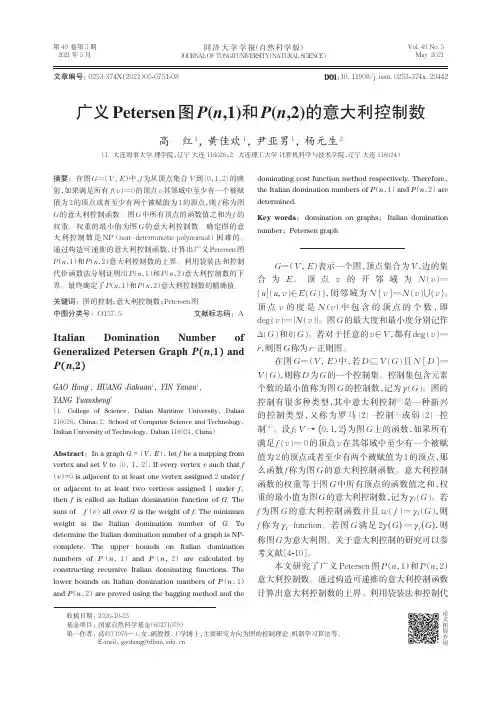
第49卷第5期2021年5月同济大学学报(自然科学版)JOURNAL OF TONGJI UNIVERSITY(NATURAL SCIENCE)Vol.49No.5May2021论文拓展介绍广义Petersen图P(n,1)和P(n,2)的意大利控制数高红1,黄佳欢1,尹亚男1,杨元生2(1.大连海事大学理学院,辽宁大连116026;2.大连理工大学计算机科学与技术学院,辽宁大连116024)摘要:在图G=(V,E)中,f为从顶点集合V到{0,1,2}的映射,如果满足所有f(v)=0的顶点v其邻域中至少有一个被赋值为2的顶点或者至少有两个被赋值为1的顶点,则f称为图G的意大利控制函数。
图G中所有顶点的函数值之和为f的权重。
权重的最小值为图G的意大利控制数。
确定图的意大利控制数是NP(non‒deterministic polynomial)困难的。
通过构造可递推的意大利控制函数,计算出广义Petersen图P(n,1)和P(n,2)意大利控制数的上界。
利用袋装法和控制代价函数法分别证明出P(n,1)和P(n,2)意大利控制数的下界。
最终确定了P(n,1)和P(n,2)意大利控制数的精确值。
关键词:图的控制;意大利控制数;Petersen图中图分类号:O157.5文献标志码:A Italian Domination Number of Generalized Petersen Graph P(n,1)and P(n,2)GAO Hong1,HUANG Jiahuan1,YIN Yanan1,YANG Yuansheng2(1.College of Science,Dalian Maritime University,Dalian 116026,China;2.School of Computer Science and Technology,Dalian University of Technology,Dalian116024,China)Abstract:In a graph G=(V,E),let f be a mapping from vertex and set V to{0,1,2}.If every vertex v such that f (v)=0is adjacent to at least one vertex assigned2under f or adjacent to at least two vertices assigned1under f,then f is called an Italian domination function of G.The sum of f(v)all over G is the weight of f.The minimum weight is the Italian domination number of G.To determine the Italian domination number of a graph is NP-complete.The upper bounds on Italian domination numbers of P(n,1)and P(n,2)are calculated by constructing recursive Italian dominating functions.The lower bounds on Italian domination numbers of P(n,1)and P(n,2)are proved using the bagging method and the dominating cost function method respectively.Therefore,the Italian domination numbers of P(n,1)and P(n,2)are determined.Key words:domination on graphs;Italian domination number;Petersen graphG=(V,E)表示一个图,顶点集合为V,边的集合为E。
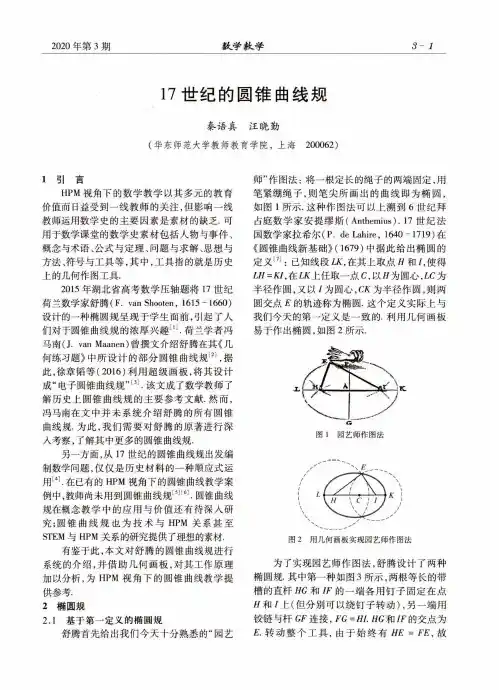
2020年第3期欽学救学3-117世纪的圆锥曲线规秦语真汪晓勤(华东师范大学教师教育学院,上海200062)1引言HPM视角下的数学教学以其多元的教育价值而日益受到一线教师的关注,但影响一线教师运用数学史的主要因素是素材的缺乏.可用于数学课堂的数学史素材包括人物与事件、概念与术语、公式与定理、问题与求解、思想与方法、符号与工具等,其中,工具指的就是历史上的几何作图工具.2015年湖北省高考数学压轴题将17世纪荷兰数学家舒腾(F.van Shooten,1615-1660)设计的一种椭圆规呈现于学生面前,引起了人们对于圆锥曲线规的浓厚兴趣⑷•荷兰学者冯马南(J.van Maanen)曾撰文介绍舒腾在其《几何练习题》中所设计的部分圆锥曲线规⑵,据此,徐章韬等(2016)利用超级画板,将其设计成“电子圆锥曲线规”⑶.该文成了数学教师了解历史上圆锥曲线规的主要参考文献•然而,冯马南在文中并未系统介绍舒腾的所有圆锥曲线规•为此,我们需要对舒腾的原著进行深入考察,了解其中更多的圆锥曲线规.另一方面,从17世纪的圆锥曲线规出发编制数学问题,仅仅是历史材料的一种顺应式运用⑷•在已有的HPM视角下的圆锥曲线教学案例中,教师尚未用到圆锥曲线规⑸同•圆锥曲线规在概念教学中的应用与价值还有待深入研究;圆锥曲线规也为技术与HPM关系甚至STEM与HPM关系的研究提供了理想的素材.有鉴于此,本文对舒腾的圆锥曲线规进行系统的介绍,并借助几何画板,对其工作原理加以分析,为HPM视角下的圆锥曲线教学提供参考.2椭圆规2.1基于第一定义的椭圆规舒腾首先给出我们今天十分熟悉的“园艺师”作图法:将一根定长的绳子的两端固定,用笔紧绷绳子,则笔尖所画出的曲线即为椭圆,如图1所示•这种作图法可以上溯到6世纪拜占庭数学家安提缪斯(Anthemius).17世纪法国数学家拉希尔(P.de Lahire,1640-1719)在《圆锥曲线新基础>(1679)中据此给出椭圆的定义⑺:已知线段氏,在其上取点H和/,使得LH=KI,在厶K上任取一点C,以H为圆心上C为半径作圆,又以/为圆心,CK为半径作圆,则两圆交点E的轨迹称为椭圆.这个定义实际上与我们今天的第一定义是一致的.利用几何画板易于作出椭圆,如图2所示.图1园艺师作图法图2用几何画板实现园艺师作图法为了实现园艺师作图法,舒腾设计了两种椭圆规•其中第一种如图3所示,两根等长的带槽的直杆HG和IF的一端各用钉子固定在点H和/上(但分别可以绕钉子转动),另一端用較链与杆GF连接,FG=HI.HG和IF的交点为E.转动整个工具,由于始终有HE=FE,故3-22020年第3期HE+IE=IF为定长,点E所形成的轨迹即为椭圆.图3舒腾的第一种椭圆规这种椭圆规的作图过程可用几何画板来实现.如图4,已知线段在其上取点H和人使得LH=IK,以点/为圆心,以线段LK为半径作圆,在圆上任取一点F,连接作的垂直平分线,交/F于点E,则当点F在圆上运动时,点E的轨迹即为椭圆.图4用几何画板实现第一种椭圆规的作图舒腾的第二种椭圆规如图5所示.四根等长的杆用较链首尾连接,构成菱形OIPG.带槽的杆OQ一端固定在点0处,并经过点P.另一根定长且带槽的杆HG一端固定在点H处(可绕H旋转),另一端是固定在点G处.HG与OP 交于点E.则转动杆HG时,因始终有GE=EI,故EH+El=GH为定长.于是,点£的轨迹为椭圆.图5舒腾的第二种椭圆规第二种椭圆规的作图过程可用几何画板来实现•如图6所示,已知线段LK,在其上取点H和/,使得LH=K/,以点H为圆心,以线段LK 为半径作圆,在圆上任取一点G,以G和/为相对的两个顶点作菱形GOIP(边长大于LI),对角线OP与HG的交点为E,则当点G在圆上运动时,点E的轨迹即为椭圆.图6用几何画板实现舒腾第二种椭圆规的作图2.2基于压缩变换定义的椭圆规舒腾的第三种椭圆规如图7所示.第一根直杆的一端固定在横杆厶K上的点A处(可绕4转动),另一端点B与第二根等长直杆的一端用较链连接•在第二根直杆上固定一个钉子E.当第二根直杆的另一端点D沿横杆滑动时,钉子E的轨迹为一个椭圆.图7舒腾的第三种椭圆规如图8,在直线LK上取一固定点A和一动点D,分别以点A和点D为圆心,以等长线段为半径作圆,交于点B,在DB上取一点E(DE 为定长),拖动点D,点E的轨迹即为椭圆.如图9,设AB=DB=m,BE=n(m>n>0),以点力为原点、LK为横轴建立坐标系,延长至点Q,使得BQ=BE=n,则点Q(”o,y。
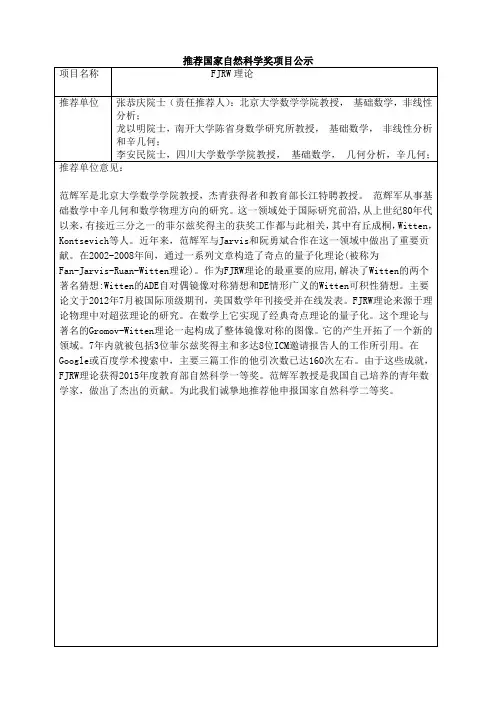
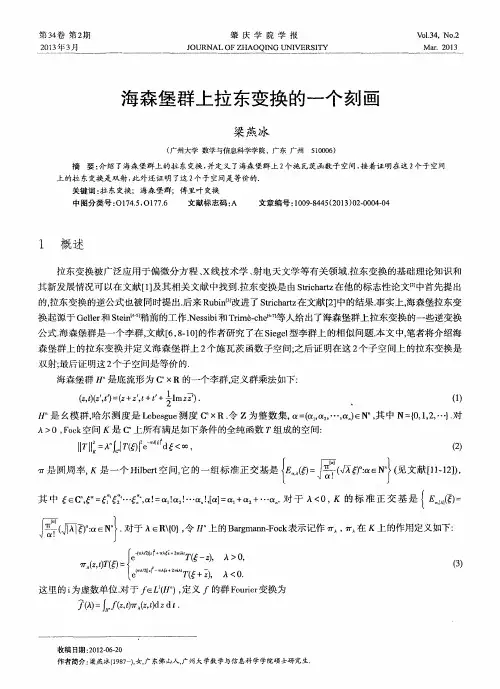
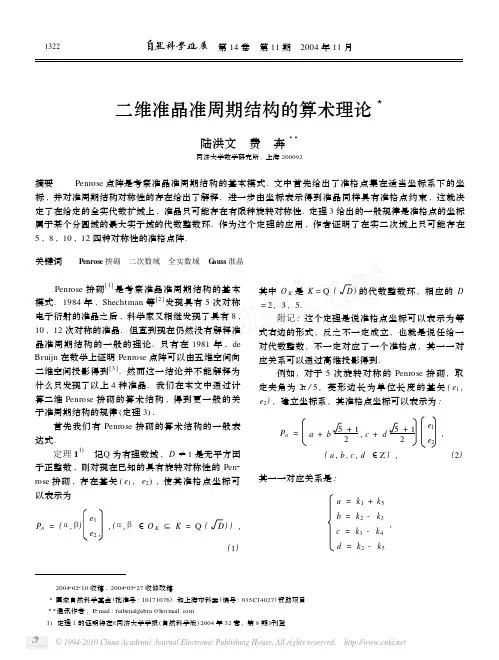
第14卷 第11期 2004年11月二维准晶准周期结构的算术理论3陆洪文 费 奔33同济大学数学研究所,上海200092 2004202210收稿,2004205227收修改稿 3国家自然科学基金(批准号:10171076)和上海市科委(编号:035C14027)资助项目 33通讯作者,E 2mail :feibenalgebra @1)定理1的证明将在《同济大学学报(自然科学版)2004年32卷,第8期》刊登摘要 Penrose 点阵是考察准晶准周期结构的基本模式.文中首先给出了准格点集在适当坐标系下的坐标,并对准周期结构对称性的存在给出了解释.进一步由坐标表示得到准晶同样具有准格点约束,这就决定了在给定的全实代数扩域上,准晶只可能存在有限种旋转对称性.定理3给出的一般规律是准格点的坐标属于某个分圆域的最大实子域的代数整数环.作为这个定理的应用,作者证明了在实二次域上只可能存在5,8,10,12四种对称性的准格点阵.关键词 Penrose 拚砌 二次数域 全实数域 G auss 准晶 Penrose 拚砌[1]是考察准晶准周期结构的基本模式.1984年,Shechtman 等[2]发现具有5次对称电子衍射的准晶之后,科学家又相继发现了具有8,10,12次对称的准晶.但直到现在仍然没有解释准晶准周期结构的一般的理论.只有在1981年,de Bruijn 在数学上证明Penrose 点阵可以由五维空间向二维空间投影得到[3].然而这一结论并不能解释为什么只发现了以上4种准晶.我们在本文中通过计算二维Penrose 拚砌的算术结构,得到更一般的关于准周期结构的规律(定理3).首先我们有Penrose 拚砌的算术结构的一般表达式.定理11) 记Q 为有理数域,D ≠1是无平方因子正整数,则对现在已知的具有旋转对称性的Pen 2rose 拚砌,存在基矢(e 1,e 2),使其准格点坐标可以表示为P n =(α,β)e 1e 2,,(α,β∈O K ΑK =Q (D )),(1)其中O K 是K =Q (D )的代数整数环,相应的D=2,3,5.附记:这个定理是说准格点坐标可以表示为等式右边的形式,反之不一定成立,也就是说任给一对代数整数,不一定对应了一个准格点,其一一对应关系可以通过高维投影得到.例如,对于5次旋转对称的Penrose 拚砌,取定夹角为2π/5,菱形边长为单位长度的基矢(e 1,e 2),建立坐标系,其准格点坐标可以表示为:P n =a +b 5+12,c +d5+12e 1e 2,(a ,b ,c ,d ∈Z ),(2)其一一对应关系是:a =k 1+k 5b =k 2-k 3c =k 3-k 4d=k 2-k 5,2231k i 满足25‖32k 1-5-14k 2+5+14k 3+5+14k 4-5-14k 5-5-14k 1+32k 2-5-14k 3+5+14k 4+5+14k 55+14k 1-5-14k 2+32k 3-5-14k 4+5+14k 55+14k 1+5+14k 2-5-14k 3+32k 4-5-14k 5-5-14k 1+5+14k 2+15+14k 3-5-14k 4+32k 5‖<distdist 是某个给定的常数,见定理2.定理2 准格点集合是离散的,即以旋转中心为圆心,任给r >0为半径作圆,落在此圆内的准格点为有限个.证明 准格点集合可由高维(n 维)空间满足一定条件的格子点向两维平面投影得到,即格子点满足到两维平面距离小于dist ,其中dist 是中心在超平面上的超立方体的2n 个顶点到超平面的最大距离[3].用向量表示格子点,记为γ=(k 1,k 2,...,k n ),其中k i ∈Z ,其在二维平面的投影记为γ0,需要证明满足‖γ0‖≤r 的准格点为有限个,因为‖γ-γ0‖<dist.得到‖γ‖-‖γ0‖<‖γ-γ0‖<dist ,所以只需证明‖γ‖<(r +dist )只有有限个整数解.记F (k 1,k 2,…,k n )=‖γ‖2=∑ni =1k 2i =(k 1,k 2,…,k n )E (k 1,k 2,…,k n )TE 是单位阵,则F (k 1,k 2,…,k n )为一正定型,所以F (k 1,k 2,…,k n )<(r +dist )只有有限个整数解,证毕.我们知道,晶格点集是一个Z 格,具有旋转对称性和平移对称性.而对于准格点集,没有平移对称性,只有旋转对称性.由上述定理1和2,我们可以给出准晶的严格定义.定义1 二维准晶是O K 格(K 是全实域)的一个离散子集,无界无限,没有平移对称性,只有旋转对称性.对于一般晶体点群,存在着晶格点约束,即点群的元素必须使格子点不动,这是一个很强的制约.所以,非恒等转动的阶只能为2,3,4,6.我们先给出准格点群的定义:定义2 S 是某给定Penrose 拚图的准格点集合.G 是S O (2)的某个子群,满足:1.任给g ∈G 和s ∈S ,有g ・s ∈S ,即g 保持S 不动,也就是说S 的元素在g 的作用下仍为S 的元素;2.G 为有限群.我们称G 为准格点集S 所对应的准格点群.对于准格点群,同样存在准格点约束.我们得到准晶准周期结构的一般规律.定理3 (准周期结构的一般规律)在建立的适当的坐标系下,准晶准格点的坐标集合是某个分圆域的最大实子域的代数整环的离散子集.分圆域记为Q (ξn ),n 恰好就是准晶的旋转对称性的次数,而这个最大实子域的扩张次数为φ(n )/2(φ(n )是Euler 函数,表示所有不大于n ,同时和n 互素的自然数的个数).证明 记K 的扩张次数是m ,g 是一非恒等转动.由于存在准格点约束,g 的迹必须满足T r (g )=2cos θ=2cos (2π/n )∈K ,所以,2cos θ满足m次有理系数方程.令ε=e 2πi/n ,则2cos (2π/n )=(ε+ε-1).所以,ε是一个2m 次有理系数方程的根.注意到εn=1,则ε∈Q (ξn ).但[Q (ξn ):Q ]=φ(n ),所以,ε是Q 上φ(n )次不可约多项式的根.所以,2m =φ(n ),即K 的扩张次数是φ(n )/2.证毕3231 第14卷 第11期 2004年11月作为定理3的应用,我们得到了二次域上所有可能存在的准格点群.引理4 Q 是有理数域,D 是无平方因子正整数,在实二次域的代数整环O K ΑK =Q (D )上,只可能存在具有5,8,10,12次旋转对称性的准晶,并且D =2,3,5.证明 由定理3,cos θ=cos (2π/n )满足二次方程f (x )=ax 2+bx +c 其中a ,b ,c ∈Q .所以φ(n )=4.所以只存在n =5,8,10,12.由K =Q (D )=Q (cos (2π/n )),得到D =2,3,5.证毕.至此,我们得出了关于二维准晶准周期结构的本质规律,并且决定了二次域上所有可能存在的准晶结构.这正是所有已经被发现的准晶结构.首先,5,8,10,12次对称准晶的准格点是实二次域代数整数环的离散子集.既然有理数域(存在晶体)和二次域(存在准晶),由此我们联想到其他任意次全实代数扩域上将存在什么形式的准晶.在全实三次扩域上,用我们的定理,将存在7,9,14,18次旋转对称的准晶.这就是下面的定理5.定理5 在全实三次域上,只可能存在具有7,9,14,18次旋转对称性的准晶.用定理3很容易证明这个结论.但是,G auss 断言(即G auss 2Wantzel 定理),当且仅当n =2e p 2…p s ,e ≥0,p i 是不同的Fermat 素数时,n 正多边形可以用直尺圆规作出[4].所以,7,9,14,18正多边形不能用直尺和圆规作出,而5,8,10,12正多边形可以用直尺圆规作出.所以有理由怀疑三次域上存在准晶的可能性.12边形之后可以用直尺圆规作出的有15,16,17,…,φ(15)=φ(16)=8,φ(17)=16,所以它们分别对应于4次和8次扩域.这些准晶我们统称为G auss 准晶.基于以上的分析,我们可以作出科学预言,G auss 准晶一定存在.希望物理学家能通过实验发现.用一张表来总结.表1扩张次数对称群的阶准周期结构11,2,3,4,6晶体25,8,10,12已发现的准晶37,9,14,18尚未发现415,16, (8)17,……………参 考 文 献1 Penrose R.The role of aesthetics in pure and applied mathematicalresearch.Bull Inst Math Appl ,1974,(10)2662 Shechtman D ,et al.Metallic Phase with long 2range orientational or 2der and no trans lational symmetry.Phys Rev Lett ,1984,(53)19513 de Bruijn N G.Algebraic theory of Penrose ’s non 2periodic tilings of the plane I ,II.Math Proc ,1981(A ),39:534 Jacobson N.Basic Algebra I.American :W.H.Freeman AngCompany ,1974.2654231 第14卷 第11期 2004年11月。
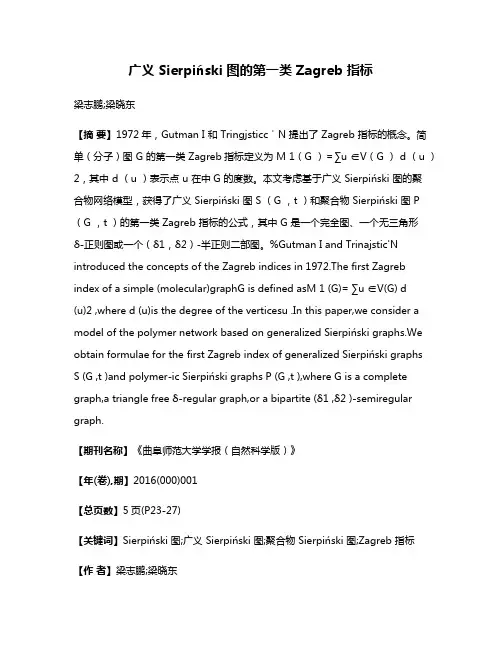
广义Sierpiński 图的第一类 Zagreb 指标梁志鹏;梁晓东【摘要】1972年,Gutman I 和 Tringjsticc'N 提出了 Zagreb 指标的概念。
简单(分子)图 G 的第一类 Zagreb指标定义为 M 1(G )=∑u ∈V(G ) d (u )2,其中 d (u )表示点 u 在中G 的度数。
本文考虑基于广义Sierpiński 图的聚合物网络模型,获得了广义Sierpiński 图 S (G ,t )和聚合物Sierpiński 图 P (G ,t )的第一类 Zagreb 指标的公式,其中 G 是一个完全图、一个无三角形δ-正则图或一个(δ1,δ2)-半正则二部图。
%Gutman I and Trinajstic'N introduced the concepts of the Zagreb indices in 1972.The first Zagreb index of a simple (molecular)graphG is defined asM 1 (G)= ∑u ∈V(G) d (u)2 ,where d (u)is the degree of the verticesu .In this paper,we consider a model of the polymer network based on generalized Sierpiński graphs.We obtain formulae for the first Zagreb index of generalized Sierpiński graphs S (G ,t )and polymer-ic Sierpiński graphs P (G ,t ),where G i s a complete graph,a triangle free δ-regular graph,or a bipartite (δ1 ,δ2 )-semiregular graph.【期刊名称】《曲阜师范大学学报(自然科学版)》【年(卷),期】2016(000)001【总页数】5页(P23-27)【关键词】Sierpiński 图;广义Sierpiński 图;聚合物Sierpiński 图;Zagreb 指标【作者】梁志鹏;梁晓东【作者单位】新疆大学数学与系统科学学院,830046,新疆维吾尔自治区乌鲁木齐市;新疆大学数学与系统科学学院,830046,新疆维吾尔自治区乌鲁木齐市【正文语种】中文【中图分类】O157.5在数学化学理论中,为了研究分子图的结构以及化合物的物理化学性质,人们提出了各种各样的拓扑指标[1,2]. 早在1972年, Gutman I和Tringjstic' N[3,4]提出了Zagreb指标,它是比较重要的一种拓扑指标. 第一类Zagreb指标和第二类Zagreb指标分别定义为:其中第一类Zagreb指标也可以表示为.对Zagreb指标的研究及应用可参考文献[3-5]. 本文用来计算几类广义Sierpiński图的第一类Zagreb指标.令G=(V,E)是一个非空简单图,V(G)为其点集,E(G)为其边集. 将由数码1,2,…,n 组成的所有t长单词的集合,记为{1,2,…,n}t. 一个t长单词u,记为u1u2…ut. 如果两个单词u和v表示的顶点相邻,则记为uv. 文献[6]已经给出了点集为{1,2,…,n}t的Sierpiński图S(Kn,t)的定义,如图1.定义1 Sierpiński 图S(Kn,t)的顶点集是V(S(Kn,t))={1,2,…,n)t.{u,v}是S(Kn,t)的一条边,当且仅当存在i∈{1,2,…,t}使得(ⅰ)ui=vj,若j<i; (ⅱ)ui≠vi; (ⅲ)uj=vi,vj=ui,若j>i.对于Sierpiński图的研究及应用可以参考文献[7-9]. 在文献[10]中,这个结构推广到了任意图,定义为广义Sierpiński图,记作S(G,t).定义2 广义Sierpiński 图S(G,t)的顶点集是V(S(G,t))={1,2,…,n}t. {u,v}是S(G,t)的一条边,当且仅当存在i∈{1,2,…,t},使得(ⅰ)ui=vj,若j<i; (ⅱ)ui≠vi,{ui,ui}∈E(G); (ⅲ)uj=vi,vj=ui,若j>i.注意到S(G,t)可以由G构造,步骤如下: 当t=1时,S(G,1)=G. 当t≥2时,首先将S(G,t-1)复制n次,然后在与x相应的那个S(G,t-1)的每个顶点标签之前添加x,对于G的每一条边{x,y},在点xyy…y和yxx…x之间添加一条边. 标号为xx…x的顶点称为极点. 对于任意n阶图G以及任意正整数t≥2,S(G,t)有n个极点. 若点x 在G中的度数为d(x),则极点xx…x在S(G,t)中的度数也为d(x). S(G,t)中的两点xyy…y和yxx…x连接S(G,t-1)的两个拷贝,故它们的度数分别为d(x)+1和d(y)+1. 当G=C6,t=2时,广义Sierpiński图S(C6,2)如图2所示.我们用Pn表示阶为n的路. 在文献[11,12]中,介绍了构造P(Kn,t)的方法,如图3. 对于n阶连通图G,文献[7]中给出了聚合物Sierpiński图P(G,t)的如下定义. 定义3 对任意i∈{1,2,…,t},定义集合Ai={ai1,a i2,…,aini-1}. 记S(G,i)=(Vi,Ei),其中则聚合物Sierpiński图P(G,t)的点集和边集分别为其中,Wj,Wj是由S在S(G,i)中的第j次复制得到的所有点与aij相连构成的边组成.注意到,P(G,t)可以由如下步骤构造得出: 当t=1时,P(G,1)是由a11连接S(G,1)的一个拷贝的每个顶点构成的. 当t=2时,为了得到P(G,2),需要运用P(G,1),A2,S(G,2); 把每一个a2j∈A2与v1j∈V1连接,并且把a2j与G在S(G,2)中的第j 个拷贝的所有点连接. 相似地,为了得到P(G,t),需要运用P(G,t-1),At,S(G,t); 把每一个atj∈At与vt-1j∈Vt-1连接,并且把atj与G在S(G,t)中的第j个拷贝的所有点连接.本文考虑基于广义Sierpiński图的聚合物网络模型,获得了广义Sierpiński图S(G,t)和聚合物Sierpiński图P(G,t)的第一类Zagreb指标的公式,其中G是一个完全图、一个无三角形δ-正则图或一个(δ1,δ2)-半正则二部图.下文中,对于一个图G,度为δ的点的个数记为NG(δ).引理1 对于任意正整数n,t≥2,有(ⅰ)NS(Kn,t)(n-1)=n; (ⅱ)NS(Kn,t)(n)=nt-n.证明由Sierpiński图S(Kn,t)的定义可知,S(Kn,t)有nt个点,分为两类: 极点和非极点,极点有n个,度数为n-1; 非极点有nt-n个,度数为n. 所以有NS(Kn,t)(n-1)=n,NS(Kn,t)(n)=nt-n.定理2 对于任意正整数n,t≥2,Sierpiński图S(Kn,t)的第一类Zagreb指标为证明根据引理1,S(Kn,t)的第一类Zagreb指标为:引理3[7] 对于任意不含三角形的n阶δ-正则图G以及任意正整数t≥2,有(ⅰ)(ⅱ).定理4 对于任意不含三角形的n阶δ-正则图G以及任意正整数t≥2,图S(G,t)的第一类Zagreb指标为:证明因为S(G,t)是度为δ,δ+1的半正则图,由引理3,引理5 令G=(U1∪U2,E)是一个阶为n=n1+n2的半正则二部图,其中|U1|=n1,|U2|=n2且δ1≠δ2. 则对任意正整数t≥2,(ⅰ)(ⅱ)(ⅲ)(ⅳ).证明广义Sierpiński图S(G,t)中顶点的度数有4类: δ1,δ1+1,δ2,δ2+1. 注意到,若S(G,t)中顶点的度数为{δ1,δ1+1} ,则它的邻点的度数分别为{δ2,δ2+1}; 若S(G,t)中顶点的度数为{δ2,δ2+1},则它的邻点的度数分别为{δ1,δ1+1}. 根据这种对称性,只需证明(ⅰ)和(ⅱ),(ⅲ)和(ⅳ)同理可证.在S(G,2)中,δ1+1度顶点都S(G,2)是中的δ2度极点的邻点,故有当t≥3时,S(G,t)中任意一个S(G,t-1)拷贝中的δ1+1度顶点在S(G,t)中仍为δ1+1度点,而任意一个在S(G,t-1)拷贝中为δ1度极点而在S(G,t)中变为δ1+1度的顶点都是另一个S(G,t-1)拷贝中某个δ2度极点的邻点. 从而,,.定理6 令G=(U1∪U2,E) 是一个阶为n=n1+n2的半正则二部图,其中|U1|=n1,|U2|=n2且δ1≠δ2. 则对任意正整数t≥2,证明因为δ1≠δ2时,S(G,t)中的点有4种可能的度数:δ1,δ2,δ1+1,δ2+1. 由n1δ1=n2δ2以及引理5,可得图S(G,t)的第一类Zagreb指标为:推论7 对任意正整数r,t≥2,图S(K1,r,t)的第一类Zagreb指标为由于P(Kn,1)≌Kn+1,根据引理1,可知M1(P(Kn,1))=n2(n+1). 当t≥2时,有如下结论:定理8 对任意正整数n,t≥2,证明设d(x)是图P(G,t)中顶点x的度数,则根据聚合物Sierpiński图的定义,将P(Kn,t)中的顶点进行分层考虑:(1)当x∈A1时,x=a11,d(x)=n,且A1中只有a11一个点;(2)当x∈V1时,d(x)=N+1,且V1中共有n个点;(3)当x∈Ai(2≤i≤t)时,d(x)=n+1,且每个Ai中共有ni-1个点;(4)当x∈Vi(2≤i≤t-1)时,根据引理1,每个Vi中共有ni个点,分为两类: 度为d(x)=n+1的点有n个; 度为d(x)=n+2的点有ni-n个;(5)当x∈Vt时,根据引理1,Vt中共有nt个点,其中度为d(x)=n的点有n个,度为d(x)=n+1的点有nt-n个.所以,P(Kn,t)的第一类Zagreb指标为注对任意阶为n≥2的δ-正则图G,图P(G,1)的第一类Zagreb指标为证明根据聚合物Sierpiński图P(G,t)的定义知,图P(G,1)中只有两类点:一个n 度点和n个δ+1度点,因此可得它的第一类Zagreb指标为M1(P(G,1))=n2+(δ+1)2)n.定理9 对于任意不含三角形的n阶δ-正则图G以及任意正整数t≥2,图P(G,t)的第一类Zagreb指标为M1(P(G,1))=αnt-β(t-2)-γ,其中证明设d(x)是图P(G,t)中顶点x的度数,根据聚合物Sierpiński图的定义,将P(G,t)中的顶点进行分层考虑:(1)当x∈A1时,x=a11,d(x)=n,且A1中只有a11一个点;(2)当x∈V1时,d(x)=δ+2,且V1中共有n个点;(3)当x∈Ai(2≤i≤t)时,d(x)=n+1,且每个Ai中共有ni-1个点;(4)当x∈Vi(2≤i≤t-1)时,根据引理3,每个Vi中共有ni个点,分为两类: 度为d(x)=δ+2的点有个,度为d(x)=δ+3的点有个;(5)当x∈Vt时,根据引理3,Vt中共有nt个点,分为两类: 度为d(x)=δ+1的点有个,度为d(x)=δ+2的点有个.所以,P(G,t)的第一类Zagreb指标为。
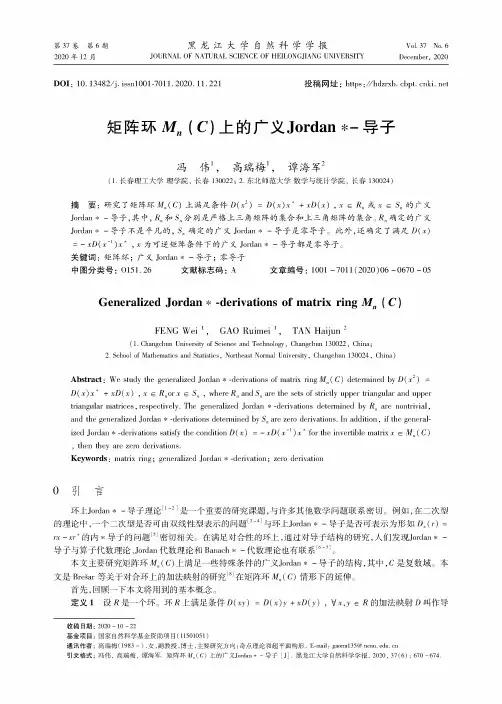
第37卷第6期黑龙江大学自然科学学报Vol.37No.6 2020年12月JOURNAL OF NATURAL SCIENCE OF HEILONGJIANG UNIVERSITY December,2020 DOI:10.13782/j.issnl001-7011.2020.11.221投稿网址:https:〃矩阵环M n(C)上的广义Jordan导子冯伟1,髙瑞梅2,谭海军2(21长春理工大学理学院,长春130022;21东北师范大学数学与统计学院,长春130024)摘要:研究了矩阵环M n{C')上满足条件D((2)二+xD(x),兀丘心或兀丘S”的广义Jordan-导子,其中,心和以分别是严格上三角矩阵的集合和上三角矩阵的集合。
心确定的广义Jordan*-导子不是平凡的,确定的广义Jordnn*-导子是零导子。
此外,还确定了满足D(() =-xD(x~l))*,)为可逆矩阵条件下的广义Jordnn*-导子都是零导子。
关键词:矩阵环;广义Jordnn*-导子;零导子中图分类号:O151.26文献标志码:A文章编号:1001-7011(2222)06-0670-05 Generalized Jrrdan*-derivations of matrix ring Mn(C)FENG Wei1,GAO Ruimei1,TAN Haijun2(1.Chanichun University of Science anl Technology,Chanichun137022,Chirm;2i School of Mathematics anl Statistics,Northeast Normnl University,Chanychuc137024,Chinn)Abstraci:Wc stuUy the yeneralizeC Jordnc*-Zerivetiocn of matric rinc M n(C)ZetermiceC byD((2)二D(())*+xD(()丘心or aw S n,whera R n anl S n art thr sein of stuctiy uppr trianculas anZ upprs tpanculas TU c ceceralizeC Jordan*-Zerivetiocn by R n art contriviai, anl th ceceralizeC Jordan*-Zerivatiocn netermileC by S n nd zro nerivatmcn.A dcWitioi,iZ P c cmdiz izd Jordan*-Zerivatiocn satisfy P c coclitioc D()二-xD(~-)x*for P ic11¥61111:>0matuv x丘M”(C) ,thr they td zro血五^七:^乞Keywords:matuv rinc;ceceralizeC Jordan*■Zdatioi;zro aerivatioc0引言环上Jordac*-导子理论[1-2]是一个重要的研究课题,与许多其他数学问题联系密切。
第1页共37页量子物理的数学和哲学基础(鲁学星2016/12/30)研究工作进行一年了,有很多基本的进展。
我们主要在四个方面取得进展。
前三个进展都是紧紧围绕着费曼图或者箭图(quiver)的自然的数学和物理意义展开的。
第四个进展是关于量子基础方面的,具体的讲,就是提出了一种改进惠勒的延迟选择实验的思路,并可能用来实现新的量子通信方案(未来光子通信)。
前三个方面的进展分别是universal 弦网凝聚,费曼流形的表示以及upward平面图的组合与拓扑理论。
其中前两个进展都是关于图嵌入技巧的数学理论,我们可以分别用图嵌入技巧来研究张量范畴(或者费曼流形)和阿贝尔范畴。
用图嵌入技巧研究规范理论并且把它代数化,我们得到了universal弦网凝聚理论。
用图嵌入技巧研究阿贝尔范畴,我们获得了对于阿贝尔范畴上的非交换辛几何的一个概念性理解,包括几何表示论和代数表示论的一些核心构造(阿贝尔/三角/DG范畴上的内蕴对称性/Ringel-Hall Hopf代数,Quiver的表示理论,量子群及其表示的几何实现,motivic技术,范畴化,几何朗兰兹对偶),以及08年康塞维奇-苏泊曼提出的公理化穿墙公式(wall crossing formula),超对称场论中的BPS结构和可积系统的之间的关系。
这一理论我们认为是一个正确的费曼流形的表示理论(详见后文分析)。
前两个理论的最关键的机制在于图嵌入技巧背后的函子性,这种函子性是我们最想揭示的内容。
我们强调这些问题都联系于量子场论的数学定义,需要一种严格的数学方法处理无限维的数学对象(比如:联络模空间,张量范畴,Hall stack,阿贝尔范畴),图嵌入技巧和Kan扩张提供了处理无穷维问题的新思路。
第三个方面的进展,即upward平面图的组合和拓扑理论,它的研究也会对理解quiver 上的拓扑序有重要意义。
在数学上,universal弦网凝聚理论是关于张量范畴和张量流形的几何理论;在物理上(目前的讨论,主要都是在formal的层次上),它是关于非微扰规范理论的理论,和格点规范理论,圈量子引力和弦网凝聚理论,以及时空和物质的演生有关。
arXiv:math/0008040v1 [math.QA] 4 Aug 2000RectanglediagramsfortheLusztigconesofquantizedenvelopingalgebrasoftypeA
RobertMarshDepartmentofMathematicsandComputerScience,UniversityofLeicester,UniversityRoad,LeicesterLE17RH,EnglandE-mail:R.Marsh@mcs.le.ac.uk
AbstractLetUbethequantumgroupassociatedtoaLiealgebragoftypeAn.ThenegativepartU−ofUhasacanonicalbasisBdefinedbyLusztigandKashi-wara,withfavourableproperties.WeshowhowthespanningvectorsoftheconesdefinedbyLusztig[12],whenregardedasmonomialsinKashiwara’srootoperators,canbedescribedusingaremarkablerectanglecombinatorics.WeusethistocalculatetheLusztigparametersofthecorrespondingcanonicalbasiselements,conjecturingthattranslatesofthesevectorsspanthesimplicialregionsoflinearityofLusztig’spiecewise-linearfunction[9,§2].Keywords:quantumgroup,canonicalbasis,Lusztigcone,longestword,piecewise-linearcombinatorics.
1IntroductionLetU=Uq(g)bethequantumgroupassociatedtoasemisimpleLiealgebragofrankn.ThenegativepartU−ofUhasacanonicalbasisBwithfavourableproperties(seeKashiwara[7]andLusztig[11,§14.4.6]).Forexample,viaactiononhighestweightvectorsitgivesrisetobasesforallthefinite-dimensionalirreduciblehighestweightU-modules.
LetWbetheWeylgroupofg,withCoxetergeneratorss1,s2,...,sn,andletw0betheelementofmaximallengthinW.Letibeareducedexpressionforw0,i.e.w0=si1si2···sikisreduced.LusztigobtainsaparametrizationofthecanonicalbasisBforeachsuchreducedexpressioni,viaacorrespondencebetweenabasisofPBW-typeassociatedtoiandthecanonicalbasis.Thisgivesabijectionϕi:B→Nk,whereN={0,1,2,...}.
Kashiwara,inhisapproachtothecanonicalbasis(whichhecallstheglobalcrystalbasis),definescertainrootoperatorsFionthecanonicalbasis(see[7,§3.5])whichleadtoaparametrizationofthecanonicalbasisforeachreducedexpressionibyacertainsubsetYiofNk.Thisgivesabijectionψi:B→Yi.ThesubsetYiiscalledthestringcone.
ThereisnosimplewaytoexpresstheelementsofBintermsofthenaturalgeneratorsF1,F2,...,Fn
ofU−.ThishasbeendoneforallofBonlyintypesA1,A2,A3andB2(see[9,§3.4],[12,§13],[20]
and[19])andappearstobecomearbitrarilycomplicatedingeneral.
AmonomialF(a1)i1F(a2)i2···F(ak)ik,whereF(a)i=Fai/[a]!,issaidtobetightifitbelongstoB.
1Lusztig[12]describedamethodwhichinlowrankcasesleadstotheconstructionoftightmonomials.Hedefined,foreachreducedexpressioniofw0,acertainconeCiinNkwhichweshallcalltheLusztigcone.LetMi={F(a1)i1F(a2)i2···F(ak)ik:a∈Ci}
bethesetofmonomialsobtainedfromelementsofCi.Lusztigshowedthat,intypesA1,A2andA3,Mi⊆B.Theauthor[14]hasextendedthistotypeA4.However,counter-examplesofXi[21]andReineke[18]showthatthisfailsforhigherrank.
Instead,onecanconsidermonomialsinKashiwara’soperatorsFi.Define,forareducedexpressioniforw0,Bi={b∈B:b≡Fa1i1Fa2i2···Fakik·1,a∈Ci}.
IthasbeenshownbyPremat[16]thatCi⊆Yi,sowehaveBi=ψ−1i(Ci).ThenitisknownthatBi=MiintypesA1,A2,A3(usingLusztig’swork[12]anddirectcalculation);itwillbeseenin[6]thatthisisalsotrueintypeA4.Thisbreaksdowninhigherranksbecauseoftheabovecounter-examples.ThusBicanberegardedasageneralisationofMiforhigherranks,anditislikelythatcanonicalbasiselementsinBiwillhaveacommonform.
Furthermore,theconesCiplayarolewithrespecttovariousreparametrizationfunctionsofthecanonicalbasis.Leti,jbereducedexpressionsforw0.Thereisareparametrizationfunction,Rji=ϕjϕ−1i:Nk→Nk(see[9,§2]);areparametrizationfunctionTji=ψjψ−1i:Yi→Yj(see[3,§§2.6,2.7]andalsotheremarkattheendofSection2of[15]).WealsodefineareparametrizationfunctionSji=ϕjψ−1i:Yi→NklinkingtheapproachesofLusztigandKashiwara.ThefunctionsRjiandTjiareknowntobepiecewise-linear,anditfollowsthatSjiisalsopiecewise-linear.Thesefunctionsareverydifficulttounderstand;theyhaverecentlybeendescribedbyZelevinskyin[4],buttheirregionsoflinearityareonlyknownintypesA1–A5,B2,C3,D4andG2(see[5]andreferencestherein).
SupposenowthatgisoftypeAn.In[13],itwasshownthatCicouldbeexpressedasthesetofnonnegativeintegralcombinationsofacertainsetofkspanningvectors,vj(i),j=1,...,n,vP(i),PapartialquiveroftypeAnassociatedtoi(asdescribedin[13]).ApartialquiveroftypeAnisaquiveroftypeAnwithsomedirectededgesreplacedbyundirectededgesinsuchawaythatthesubgraphofdirectededgesisconnected.
Ifanelementa=(a1,a2,...,ak)∈Ciiswrittena=(aα)α∈Φ+,whereΦ+isthesetofpositiverootsofgandaα=ajwhereαisthejthrootintheorderingonΦ+inducedbyi,thenthevj(i)andthevP(i)donotdependoniandaredescribedin[13].ThesevectorshavealsobeenstudiedbyB´edard[1]intermsoftherepresentationtheoryofquivers.Hereweshowthatifa=(a1,a2,...,ak)isoneofthesevectorsthenthecorrespondingmonomialofKashiwara’soperatorsFa1i1Fa2i2···Fakik·1canbedescribedusingaremarkablerectanglecombinatorics.